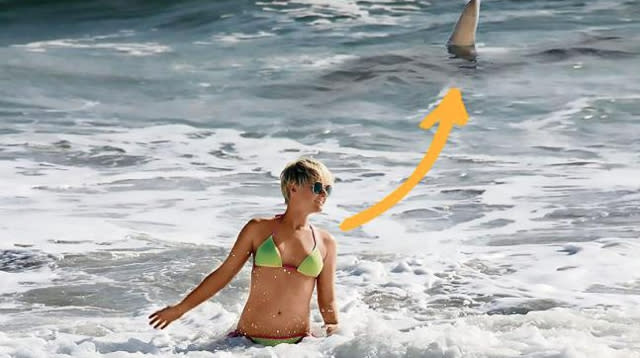Model oblivious to huge tiger shark right behind her

A German model has told of the moment she thought people were waving at her to be nice - but they were actually trying to tell her there was an enormous tiger shark swimming right behind her.
Simone Gutsche was enjoying some beach time on holiday in Cape Canaveral, Florida, when she decided to take a dip at Cocoa Beach.
See also: Great white shark leaps through air in front of tourists
See also: Great white shark attacks inflatable boat
She said she waved back at people trying to warn her, believing they were just saying hello.
But she soon became concerned that something wasn't right and got out of the water.
According to news.com.au, she said: "A couple waved to me full of excitement. Out of friendliness, I waved back.
"The people at the beach told me that just 16 feet (4.8m) behind me a shark was swimming."
According to the Metro, she was then shown a picture a witness took of the scene, and said she was so terrified she didn't get back in the water for days.
Some sceptics online have said they believe the picture to be some clever work with Photoshop.
Tiger sharks are commonly found in the waters around Cape Canaveral, along with great white sharks.
Although sharks rarely bite humans, the tiger shark is reported to be responsible for a large percentage of fatal shark bite incidents, and is sometimes regarded as one of the most dangerous shark species.
They often visit shallow reefs, harbours, and canals, creating the potential for encounter with humans. The tiger shark also dwells in river mouths and other runoff-rich water. While the tiger shark is considered to be one of the sharks most dangerous to humans, its bite rate is low. It is second on the list of number of recorded bites on humans, with the great white shark being first.
The tiger shark can grow to over five metres in length. It is found in many tropical and temperate waters, and it is especially common around the central Pacific islands.
Between 1959 and 2000, 4,668 tiger sharks were culled in Hawaii in an effort to protect the tourism industry. These efforts, despite damaging the shark population, were shown to be ineffective in decreasing the number of interactions between humans and tiger sharks.
The tiger shark is considered a near threatened species due to finning and fishing by humans.




